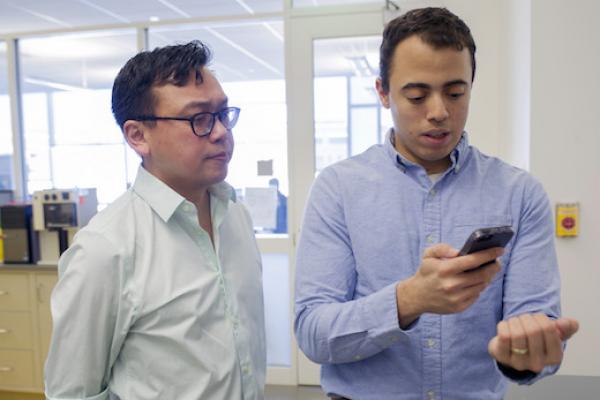Biomedical engineers from the Georgia Institute of Technology and Emory University have developed a smartphone app with the aim of non-invasive detection of anemia. Instead of a blood test, the app uses photos of someone’s fingernails taken on a smartphone to determine whether the level of hemoglobin in their blood seems low.
The results were published Tuesday, Dec. 4 by Nature Communications.
“All other ‘point-of-care’ anemia detection tools require external equipment, and represent trade-offs between invasiveness, cost, and accuracy,” says principal investigator Wilbur Lam, a researcher in the Petit Institute for Bioengineering and Bioscience at Georgia Tech, and assistant professor in the Wallace H. Coulter Department of Biomedical Engineering at Georgia Tech and Emory.
“This is a standalone app that can look at hemoglobin levels without the need to draw blood,” adds Lam, a clinical hematologist at the Aflac Cancer and Blood Disorders Center of Children’s Healthcare of Atlanta who is also on the faculty at the Emory University School of Medicine.
The app is part of the PhD work of former biomedical engineering graduate student Rob Mannino, who was motivated to conduct the research by his own experience living with beta-thalassemia, an inherited blood disorder caused by a mutation in the beta-globin gene.
“Treatment for my disease requires monthly blood transfusions,” says Mannino, who was a Petit Scholar as an undergraduate student at Georgia Tech. “My doctors would test my hemoglobin levels more if they could, but it’s a hassle for me to get to the hospital in between transfusions to receive this blood test. Instead, my doctors currently have to just estimate when I’m going to need a transfusion, based on my hemoglobin level trends.”
“This whole project couldn’t have been done by anyone but Rob,” Lam says. “He took pictures of himself before and after transfusions as his hemoglobin levels were changing, which enabled him to constantly refine and tweak his technology on himself in a very efficient manner. So essentially, he was his own perfect initial test subject with each iteration of the app.”
Mannino and Lam say that their app could facilitate self-management by patients with chronic anemia, allowing them to monitor their disease and to identify the times when they need to adjust their therapies or receive transfusions, possibly reducing side effects or complications of having transfusions too early or too late.
The researchers say that the app should be used for screening, not clinical diagnosis. The technology could be used by anyone at any time, and could be especially appropriate for pregnant women, women with abnormal menstrual bleeding, or runners/athletes. Its simplicity means it could be useful in developing countries. Clinical diagnostic tools have strict accuracy requirements, but Mannino and Lam think that with additional research, they can eventually achieve the accuracy needed to replace blood-based anemia testing for clinical diagnosis.
Anemia is a blood condition that affects two billion people worldwide and can lead to fatigue, paleness and cardiac distress if left untreated. The current gold standard for anemia diagnosis is known as a complete blood count (CBC).
The researchers studied fingernail photos and correlated the color of the fingernail beds with hemoglobin levels measured by CBC in 337 people: some healthy, and others with a variety of anemia diagnoses. The algorithm for converting fingernail color to blood hemoglobin level was developed with 237 of these subjects and then tested on 100.
The researchers were able to show that a single smartphone image, without personalized calibration, can measure hemoglobin level with an accuracy of 2.4 grams/deciliter with a sensitivity of up to 97 percent. Personalized calibration, tested on four patients over the course of several weeks, can improve the accuracy to 0.92 grams/deciliter, a degree of accuracy on par with point-of-care blood-based hemoglobin tests. Normal values are 13.5-17.5 grams/deciliter for males and 12.0-15.5 grams/deciliter for females.
In the app, the use of fingernail beds, which do not contain melanin, means the test can be valid for people with a variety of skin tones. The accuracy is consistent for dark or light skin tones, Mannino says. The app uses image metadata to correct for background brightness, and can be adapted to phones from multiple manufacturers.
Mannino and Lam say they are working with a variety of doctors at Children’s and Emory – geriatric, internal medicine, neonatologists, transfusion medicine, global health – to obtain additional data and better calibrate their system.
“This is just a snap shot of the accuracy right now,” Lam says. “The algorithm gets smarter with every patient enrolled.”
The research was supported by the National Science Foundation (Graduate Research Fellowship DGE-1650044 and Southeastern Nanotechnology Infrastructure Corridor 1542174), the 2017 Massachusetts General Hospital Primary Care Technology Prize, and National Institutes of Health (R21 EB025646).
The smartphone anemia app is projected to be available commercially for public download as soon as Spring of 2019. A patent application has been filed for the anemia app, and Wilbur Lam and Rob Mannino have a financial interest in the success of this product.
Media Contact
Walter Rich
Keywords
Latest BME News
Jo honored for his impact on science and mentorship
The department rises to the top in biomedical engineering programs for undergraduate education.
Commercialization program in Coulter BME announces project teams who will receive support to get their research to market.
Courses in the Wallace H. Coulter Department of Biomedical Engineering are being reformatted to incorporate AI and machine learning so students are prepared for a data-driven biotech sector.
Influenced by her mother's journey in engineering, Sriya Surapaneni hopes to inspire other young women in the field.
Coulter BME Professor Earns Tenure, Eyes Future of Innovation in Health and Medicine
The grant will fund the development of cutting-edge technology that could detect colorectal cancer through a simple breath test
The surgical support device landed Coulter BME its 4th consecutive win for the College of Engineering competition.








